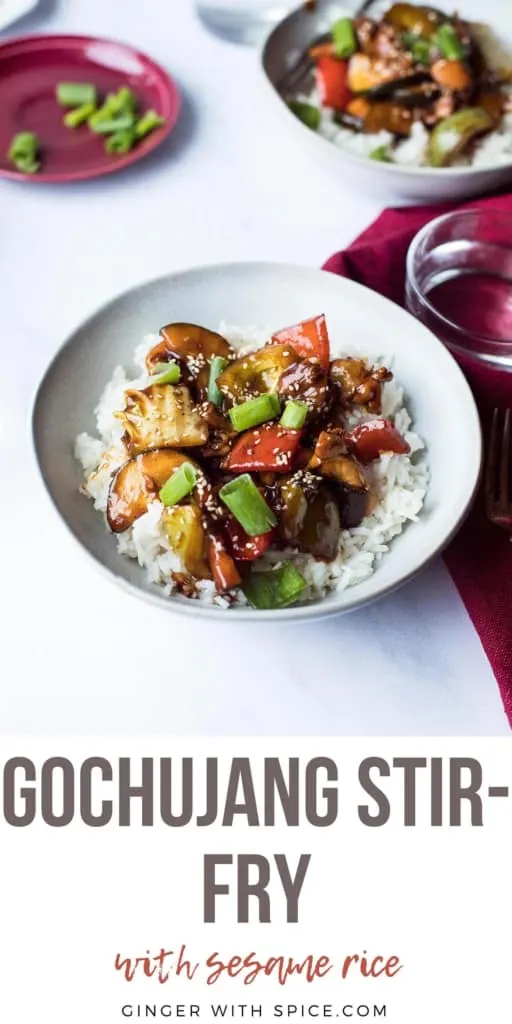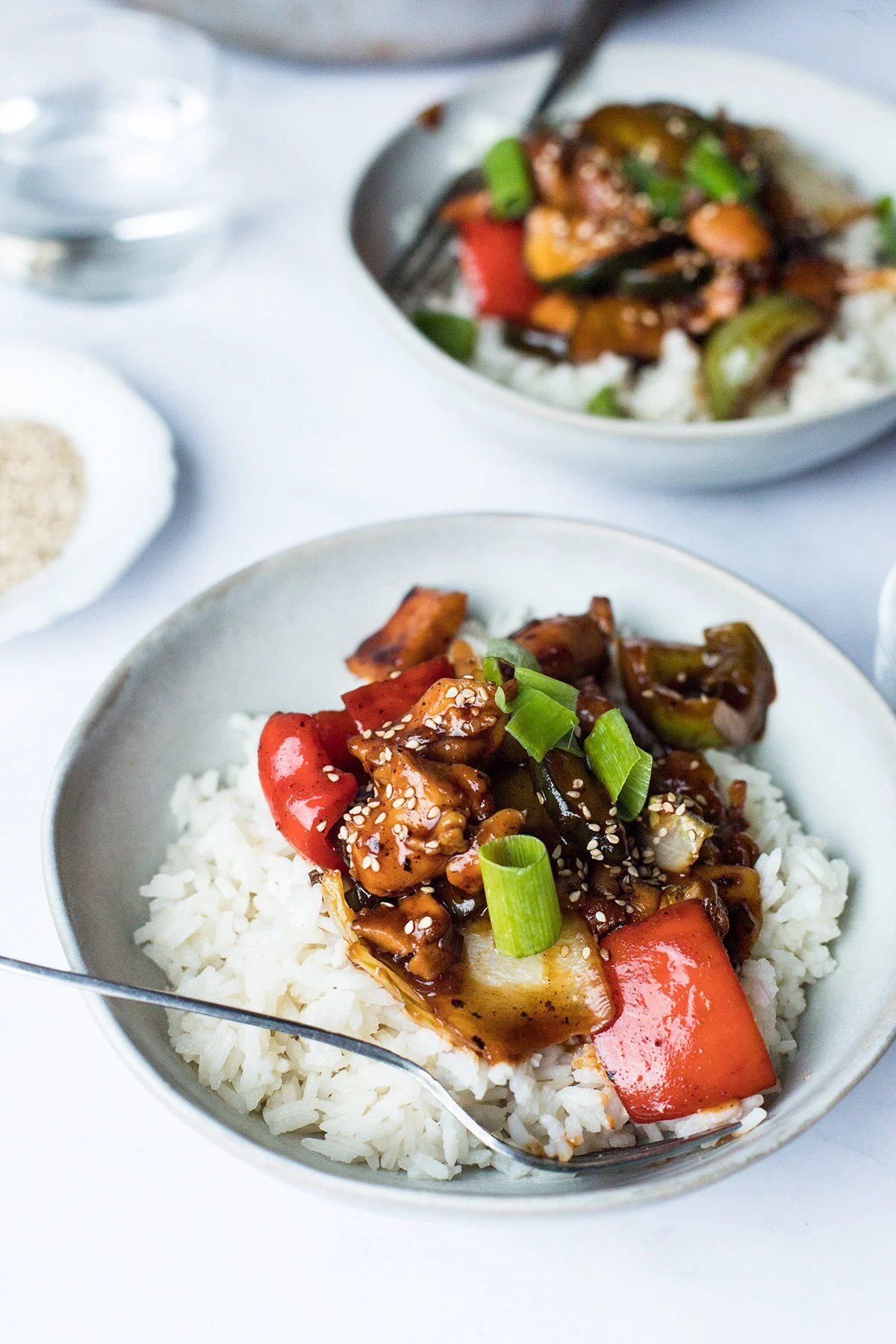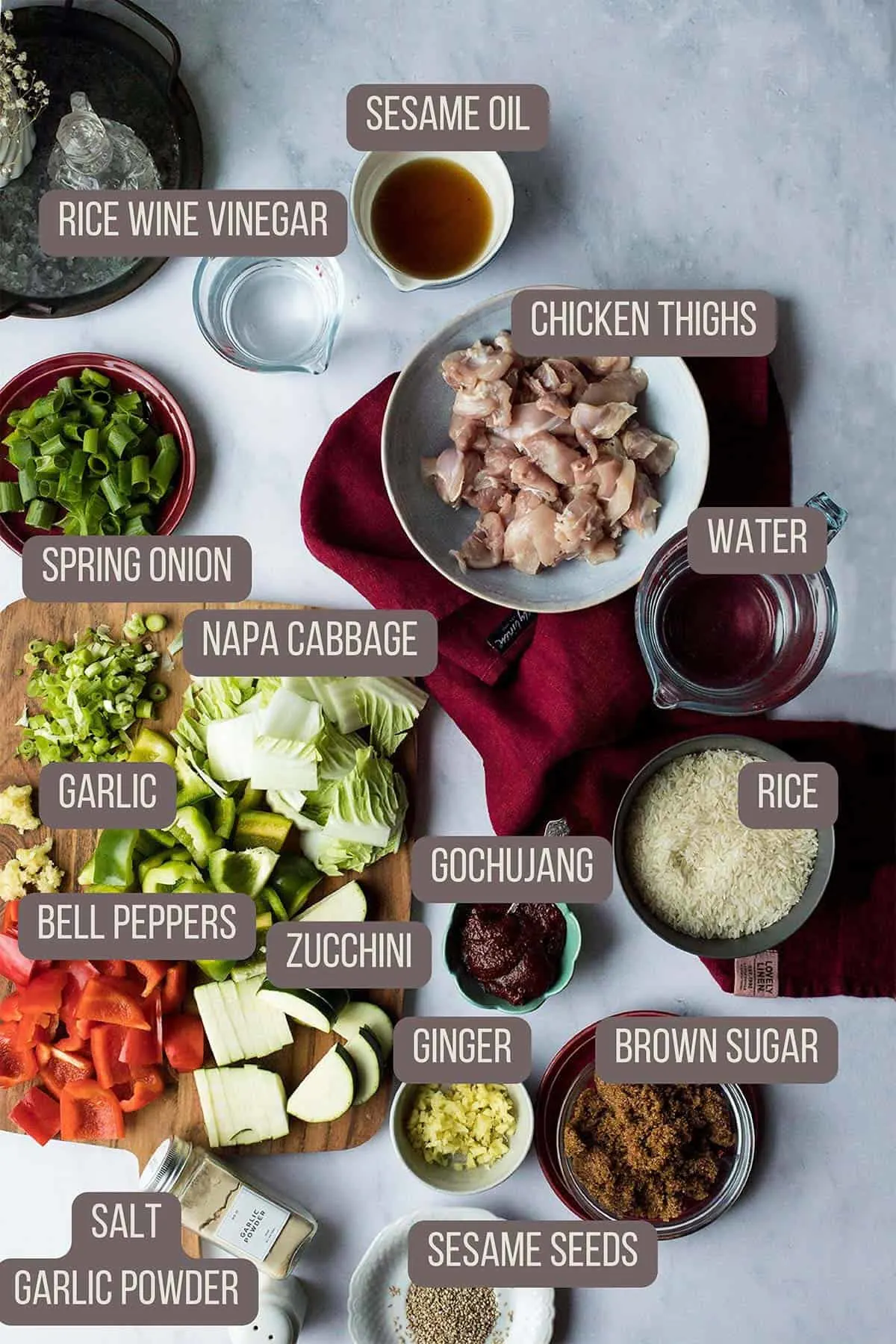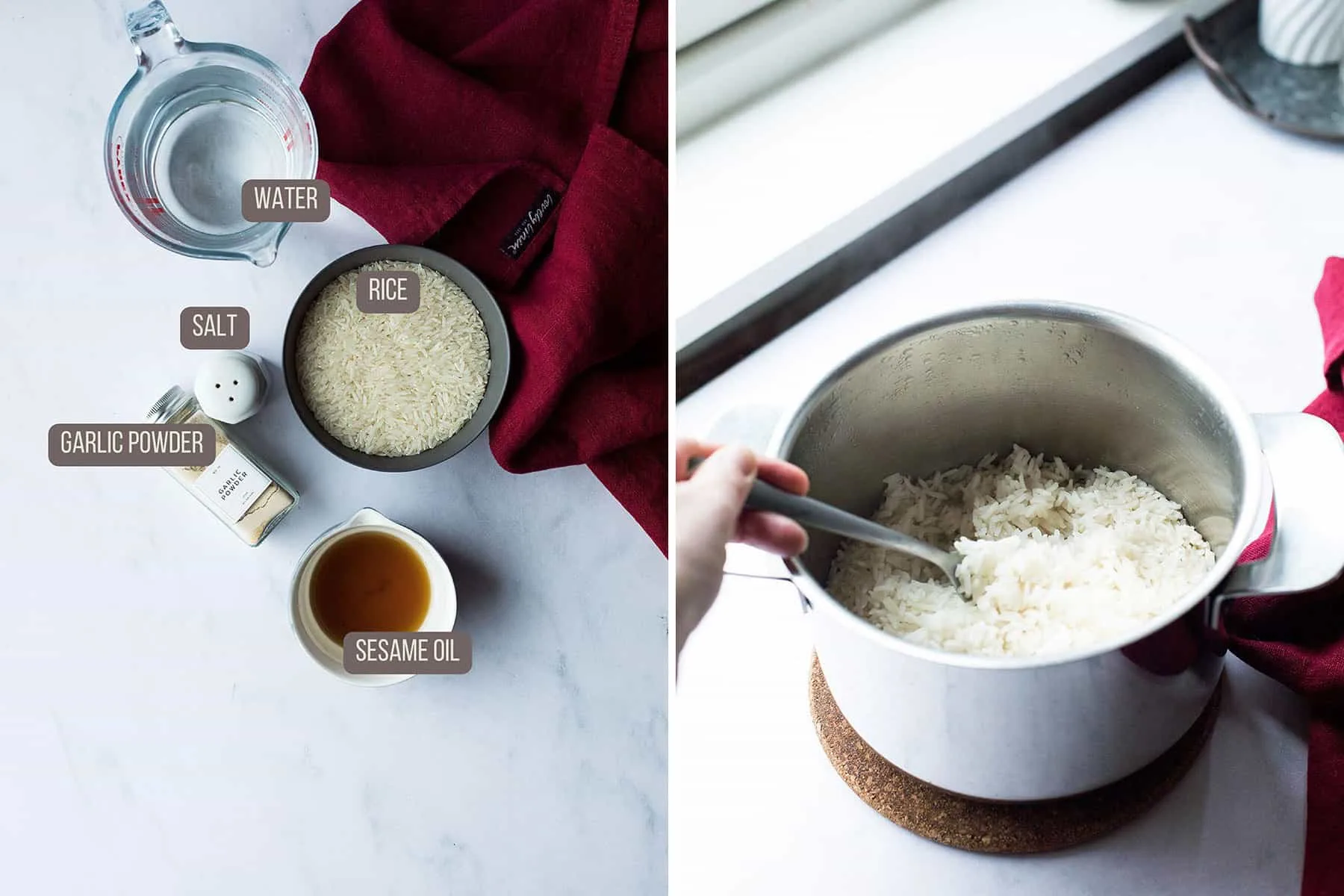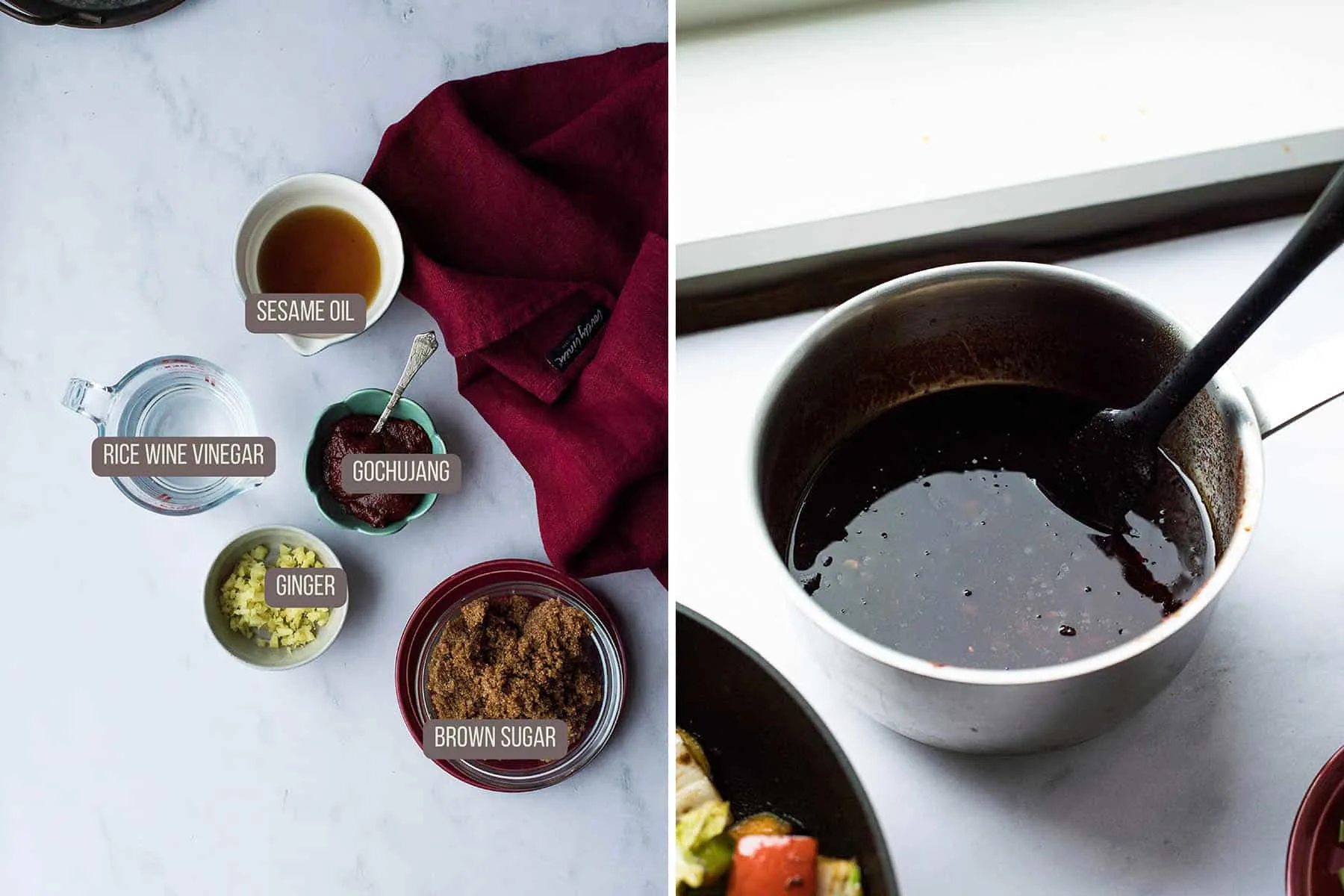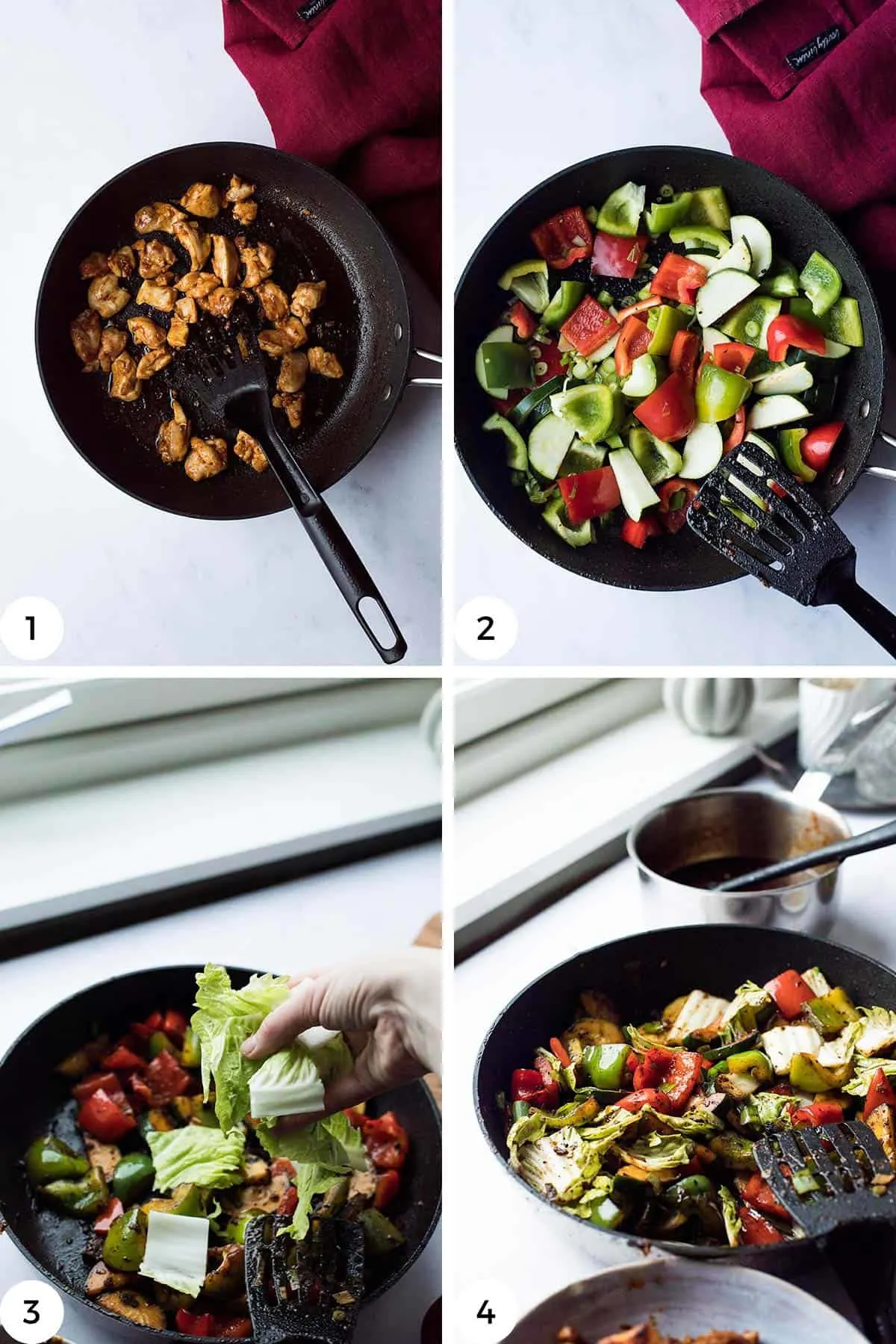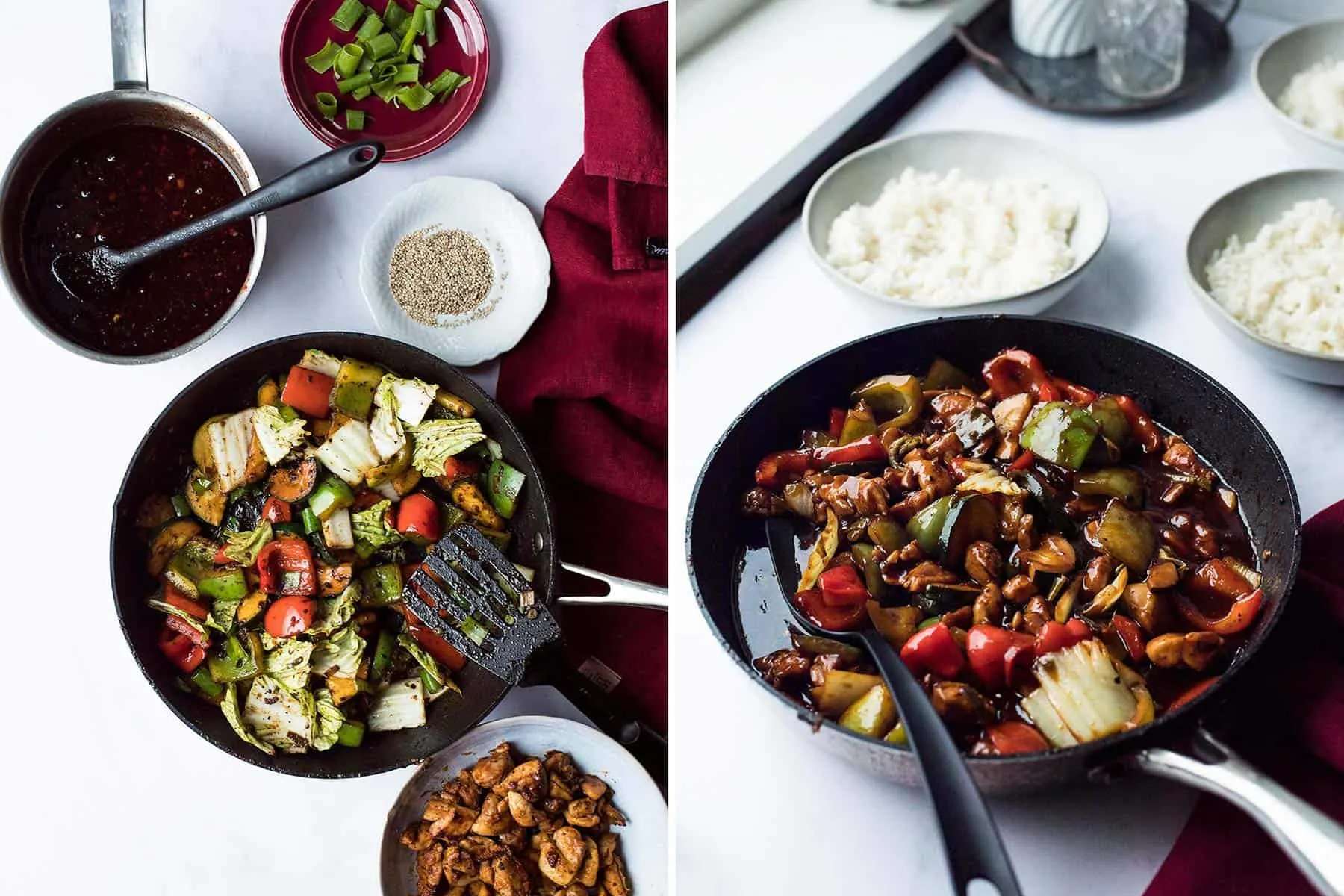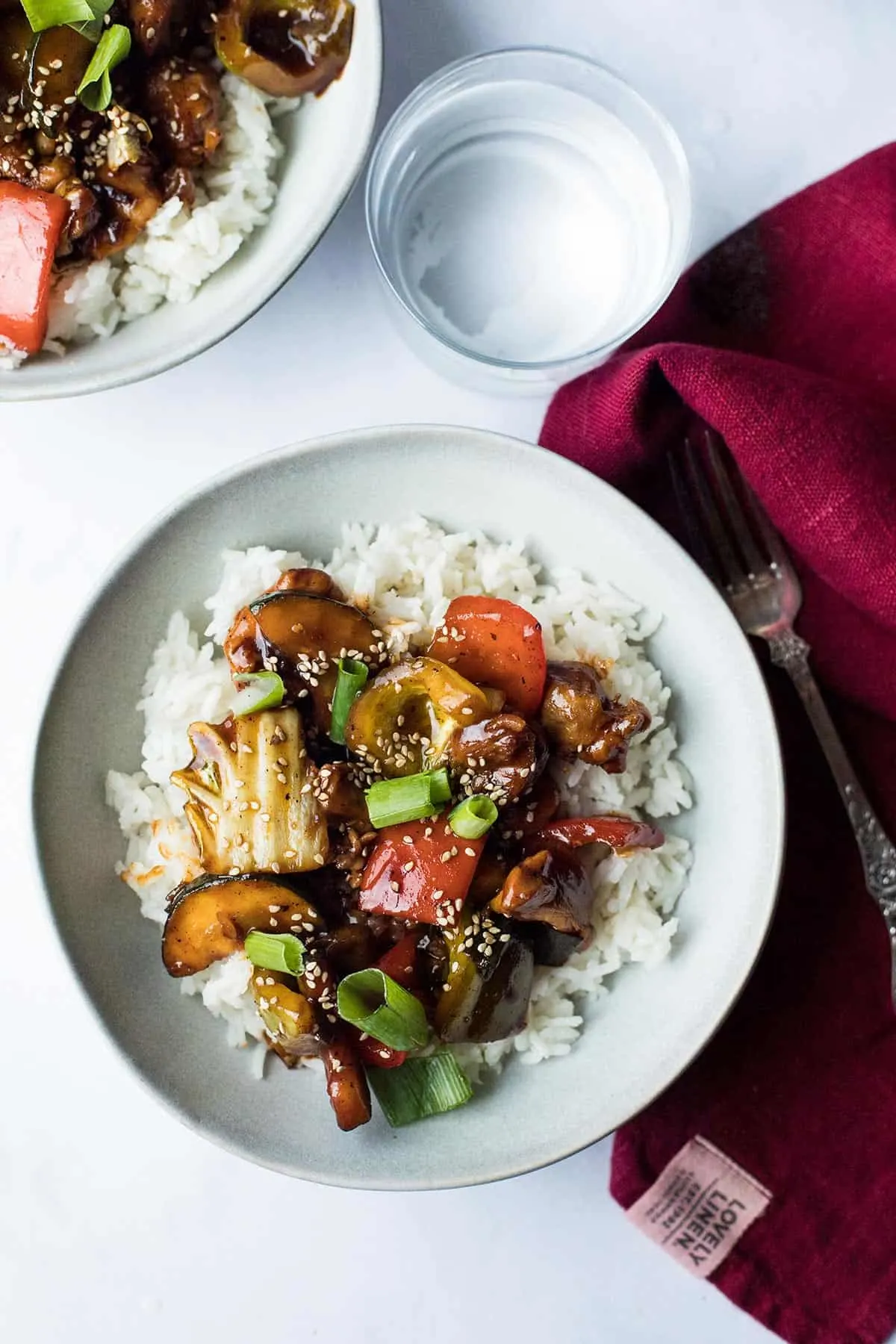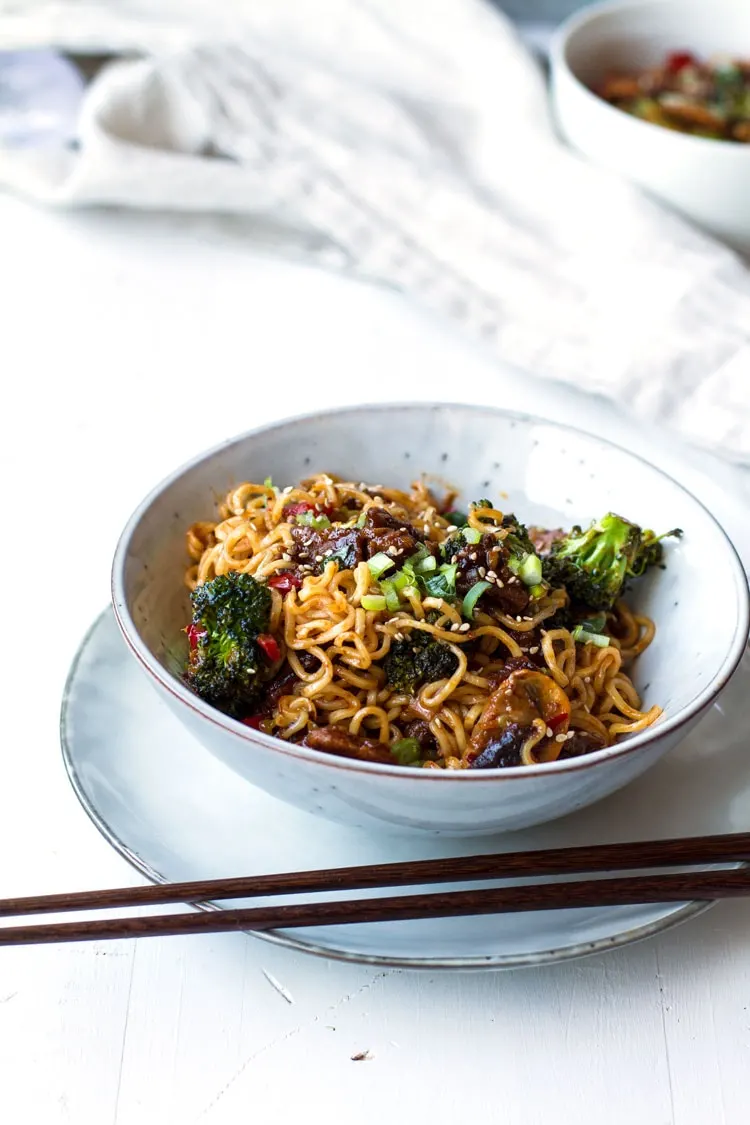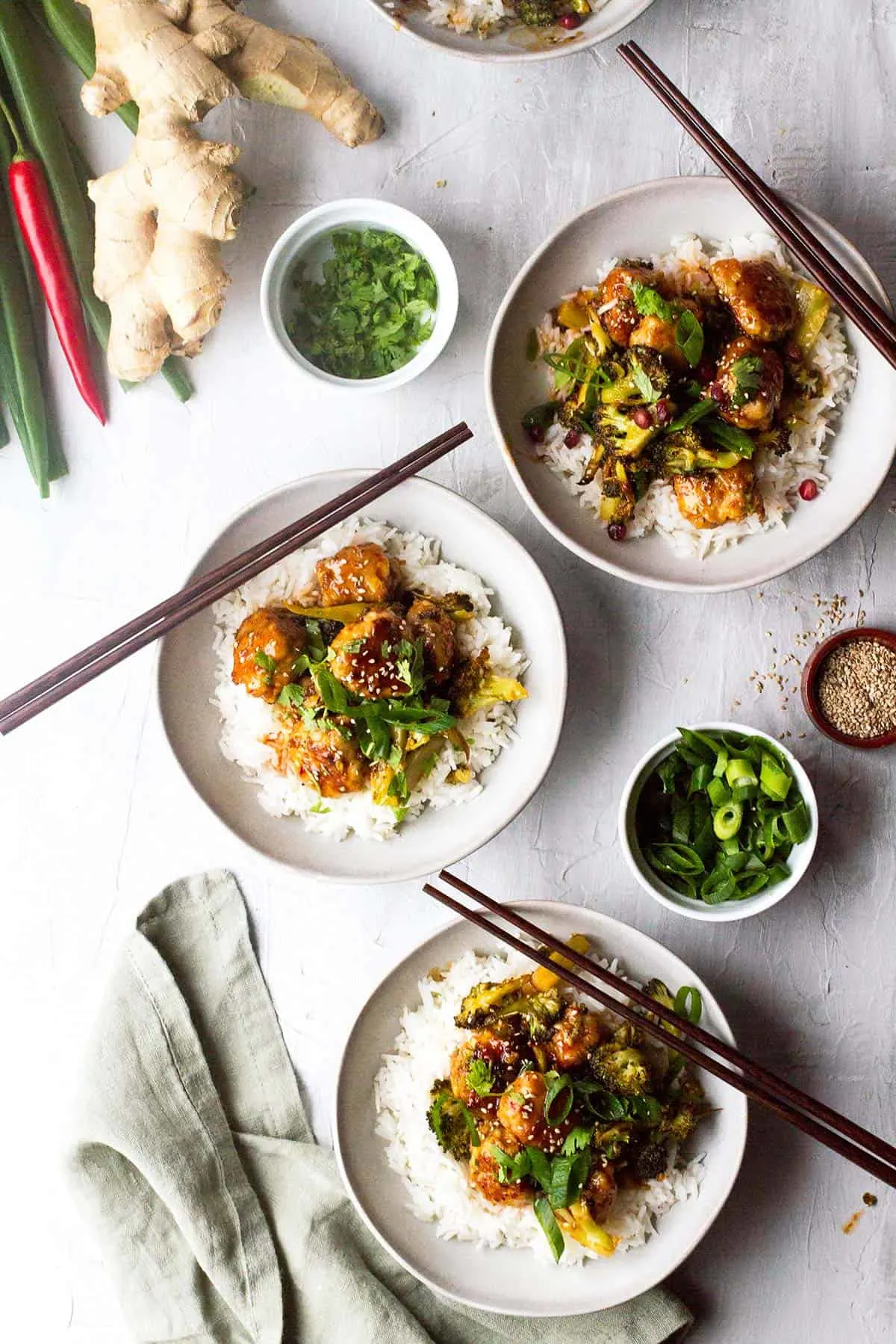This chicken gochujang stir-fry is a sweet, sticky, and spicy delight. It has intense flavors, lots of crunch from the vegetables, and nutty sesame rice to tie it all together. Due to the gochujang, you don't need that many spices and it's quite easy to make!

I am a sucker for sweet and sticky, Asian dishes. Hence why my all-time favorite beef recipe is this orange Szechuan beef and carrots, a much easier, but delicious second, is this sweet glazed beef and broccoli dish.
Sweet and sticky also works wonders with these Chinese-style pork meatballs and sriracha pork stir-fry.
Why you’ll love this recipe
You will love this gochujang stir-fry because
- It has flavor in every step - even the rice
- A delicious balance between sweet, savory, and sour
- It can range from mildly spicy to super hot depending on your liking
- Gochujang is an easy way to get a lot of deep, complex flavors without a ton of ingredients
- Crunchy, fresh vegetables
- Juicy chicken
- Nutty sesame oil for a rounder flavor profile
- It is simply, wildly GOOD.
Ingredients
For this recipe you will need the following:
- Chicken thighs - for quick stir-fries (or woks as we say in Norway), I really like to use chicken thighs. They are juicy and nearly impossible to dry out.
- Red and green bell pepper - the perfect veggie to add to a wok. I like to keep them rather large so they stay crunchy.
- Zucchini - turns soft and takes in allll the flavor of the sauce. A delicious counterpart to the crunchy bell peppers.
- Spring onion - or regular onion, but I love the freshness of spring onion. I keep the white and green parts separated. The green part as crunch at the end of the cooking time, and the white as flavoring early in the cook.
- Napa cabbage - as an ode to Korea and Korean kimchi. A lovely extra crunch to the Gochujang stir fry.
- Garlic - for an extra savory flavor.
- Gochujang - a spicy Korean fermented chili paste. It is sticky and glutinous from rice and fermented soybeans. It is a complex and savory, spicy paste that works well in many dishes. I also use it in this Korean bulgogi, but you can definitely use it in non-Korean food too.
- Brown sugar - for balancing out the spicy gochujang, making it a round, sweet, and savory sauce.
- Rice wine vinegar - to balance the sweetness. A sauce like this is all about the spicy, sour, and sweet. Vinegar is obviously the sour part of that equation!
- Fresh ginger - for a fresh and spicy touch.
- Sesame oil - sesame oil is fantastic in many Asian dishes and is one of my favorite ways to flavor sauces, rice, and noodle dishes.
- Sesame seeds - a delicious, nutty addition right before serving. And it looks pretty!
Step-by-step instructions
Chop and prepare all the vegetables and chicken thighs. Keep the vegetables large so they stay crunchy. I like to cut the zucchini in half-moons about ½ inch thick. Divide the green onion; finely chop the white part and roughly chop the green part.
Then prepare the rice. Boil water and add uncooked rice, sesame oil, garlic powder, and salt. Give it a stir. Put on the lid and cook for 17 minutes over low heat (or as per package instructions). Set aside for 5 minutes, then fluff it with a fork.
Meanwhile, heat canola oil in a skillet over medium-high heat. Cook chicken pieces (1), half of the garlic, salt, and gochujang for 2 minutes on each side. Stir often. Set aside. In order to not overcrowd the pan, you might want to do this in two batches.
Make the sauce in a medium saucepan. Over medium-high heat, bring brown sugar and rice wine vinegar to a boil. Stir in gochujang and ginger and cook until it thickens. About 15-20 minutes. Stir in sesame oil at the end.
In the same skillet as for the chicken, cook the vegetables (2). Reduce the heat to medium, add the rest of the garlic, cook for 30 seconds, then add in the bell pepper, zucchini, and white part of the spring onion.
Cook for 5-7 minutes or until the bell pepper is getting soft. Add in the napa cabbage (3-4) and most of the green part of the spring onion at the last minute.
Pour the sauce onto the chicken and vegetables and coat well. If the sauce is a little too thin, mix 1 teaspoon cornstarch with 2 tablespoons water and stir into the sauce.
Serve the gochujang stir-fry over a bowl of sesame rice. Garnish with some of the green part of the spring onion and sesame seeds.
Storage
Gochujang chicken stir-fry is a dish that works well as leftovers. The dish will develop in flavor and can turn even spicier. Keep it covered in the refrigerator for 3-4 days.
For the sesame rice, it's important that the rice quickly gets into the refrigerator (max 1-1.5 hours at room temperature). If rice is left at room temperature for too long, the spores in the rice can grow bacteria, which can result in food poisoning.
When reheating, do it slowly over medium-low heat. That way things won't burn. If things are too sticky to your liking, add a touch of water.
Recipe FAQs
What does gochujang taste like?
Gochujang is a chili paste made with fermented soybeans, glutinous rice and of course Korean chili flakes. It is sweet, salty, and spicy. The texture is very thick and sticky.
What can I use instead of gochujang?
You will need something that is sweet, salty, spicy, and sometimes thick and sticky depending on the use.
Good choices are usually sriracha although it's not as sweet, or hoisin sauce which is not as spicy. Both are easy to fix with just a little sugar or more chili flakes!
Read more about gochujang substitutes here.
Is gochujang hotter than sriracha?
I believe they are fairly similar in spice level. The key differences are texture (gochujang is thick and sticky and sriracha is a smooth sauce) and where they get their umami from (gochujang from fermented soybeans and sriracha from garlic).
Both are sweet, spicy, and delicious!
What is a stir fry?
Stir fry is a Chinese cooking technique where you fry meat and vegetables over high-heat in a wok. Stirring the pan frequently ensures that all the food gets cooked at the same time and nothing gets scorched.
The sauce is often added right at the end of the vegetables' cook time.
Expert tips
Variations
A stir fry like this can be made in a myriad of different ways. Whatever vegetables you like, whatever protein you like. Pork is another great option with spicy gochujang.
Make sure you use some crunchy vegetables, like large chunks of onion or asparagus, and some soft that absorb the flavors of the sauce, like mushrooms.
You can use other chili pastes too, although the flavor may be a little different. Gochujang is fermented, so it's kind of sour, however, you can add more rice wine vinegar to balance this.
Sriracha is a great option like I did in this Sriracha pork stir fry. Although switching up the sauce ingredients tends to make it harder to keep to the recipe, I'll just mention that it's possible, although I cannot provide measurements.
It's not important to keep measurements correct, it's about what you have on hand, and tasting the sauce as you go along.
Enjoy!
Did you like this recipe? Here are more sweet and sticky dishes I think you’d love:
I’d love to hear your thoughts. Comment below or tag me @thegingerwithspice on Instagram. And don’t forget to Pin it for later! To make sure you’re never missing another recipe, please feel free to subscribe to my newsletter.
As thanks, you will receive a free e-cookbook Travels Through the Seasons, with many delicious recipes from around the world that suit different seasons of the year.
To keep the blog up and running this post may contain affiliate links, it will be at no extra cost to you, please read the disclosure for more information.
📖 Recipe
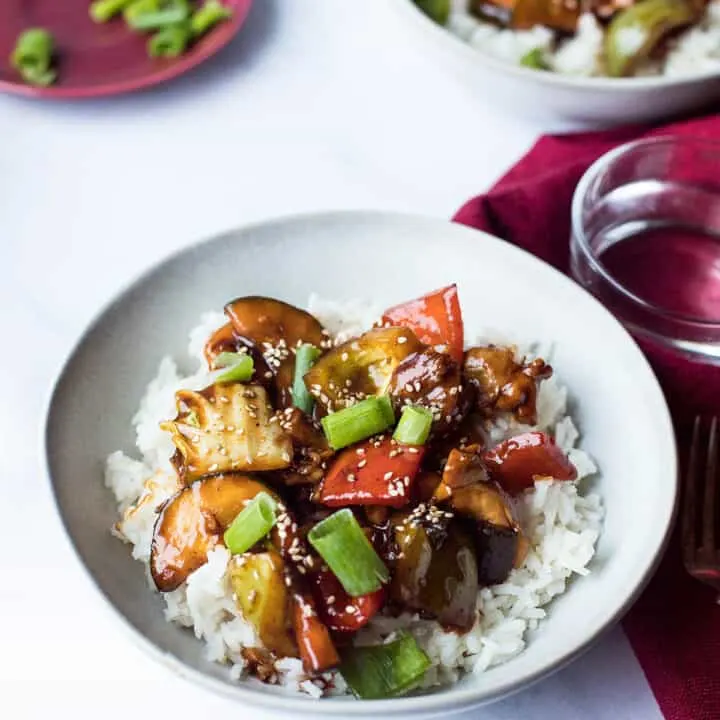
Sweet and Sticky Gochujang Stir-Fry with Sesame Rice
Chicken gochujang stir-fry is a sweet, sticky, and spicy delight. With intense flavors, vegetable crunch, and nutty sesame rice to tie it together.
Ingredients
Gochujang Stir-Fry
- 1.2 lbs chicken thighs (550 grams, or pork, cut into cubes)
- 1 red bell pepper, cut into large chunks
- 1 green bell pepper, cut into large chunks
- ½ zucchini, cut into ½-inch half-moons
- 4 spring onion, divide green (roughly chopped) and white part (finely chopped)
- 1 cup chunks of napa cabbage (100 grams, optional)
- 3 cloves of garlic, grated
- 1 tablespoon canola oil
- 1-2 teaspoon(s) gochujang
- ½ teaspoon salt
- 1 tablespoon sesame seeds
Sauce
- ¾ cup brown sugar (150 grams)
- ⅞ cup rice wine vinegar (200 milliliters)
- 2 tablespoons gochujang
- 1 tablespoon ginger, finely chopped
- 2 tablespoons sesame oil
- 1 teaspoon cornstarch + 2 tablespoons water, if desired
Sesame Rice
- 10 ounces uncooked rice (300 milliliters)
- 2 cups water (500 milliliters, or as per package instructions)
- 2 teaspoons sesame oil
- ¾ teaspoon garlic powder
- ½ teaspoon salt
Instructions
- Chop and prepare all the vegetables and chicken thighs.
- Prepare the rice: Boil water and add uncooked rice, sesame oil, garlic powder, and salt. Give it a stir. Put on the lid and cook for 17 minutes over low heat (or as per package instructions). Set aside for 5 minutes, then fluff it with a fork.
- Heat canola oil in a skillet over medium-high heat. Cook chicken pieces, half of the garlic, salt and gochujang for 2 minutes on each side. Stir often. Set aside. In order to not overcrowd the pan, you might want to do this in two batches.
- Meanwhile, make the sauce in a saucepan. Over medium-high heat, bring brown sugar and rice wine vinegar to a boil. Stir in gochujang and ginger and cook until it thickens. About 15-20 minutes. Stir in sesame oil at the end.
- In the same skillet as for the chicken, cook the vegetables. Reduce the heat to medium, add the rest of the garlic, cook for 30 seconds, then add in the bell pepper, zucchini and white part of the spring onion. Cook for 5-7 minutes or until the bell pepper is getting soft. Add in the napa cabbage and most of the green part of the spring onion the last minute.
- Pour the sauce on to the chicken and vegetables and coat well. If the sauce is a little too thin, mix 1 teaspoon cornstarch with 2 tablespoons water and stir into the sauce.
- Serve the gochujang stir-fry over a bowl of sesame rice. Garnish with some of the green part of the spring onion and sesame seeds.
Nutrition Information:
Yield: 4 Serving Size: ¼Amount Per Serving: Calories: 843Total Fat: 24gSaturated Fat: 4.6gTrans Fat: 0gCholesterol: 121mgSodium: 1067mgCarbohydrates: 97.6gFiber: 3.9gSugar: 35.6gProtein: 47.2g
Nutrition information isn't always accurate, estimate for informational purposes only.

